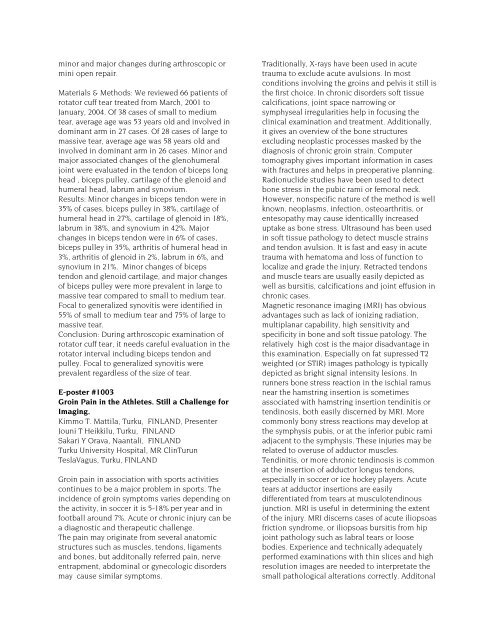POSTER ABSTRACTS - ISAKOS
POSTER ABSTRACTS - ISAKOS
POSTER ABSTRACTS - ISAKOS
You also want an ePaper? Increase the reach of your titles
YUMPU automatically turns print PDFs into web optimized ePapers that Google loves.
minor and major changes during arthroscopic or<br />
mini open repair.<br />
Materials & Methods: We reviewed 66 patients of<br />
rotator cuff tear treated from March, 2001 to<br />
January, 2004. Of 38 cases of small to medium<br />
tear, average age was 53 years old and involved in<br />
dominant arm in 27 cases. Of 28 cases of large to<br />
massive tear, average age was 58 years old and<br />
involved in dominant arm in 26 cases. Minor and<br />
major associated changes of the glenohumeral<br />
joint were evaluated in the tendon of biceps long<br />
head , biceps pulley, cartilage of the glenoid and<br />
humeral head, labrum and synovium.<br />
Results: Minor changes in biceps tendon were in<br />
35% of cases, biceps pulley in 38%, cartilage of<br />
humeral head in 27%, cartilage of glenoid in 18%,<br />
labrum in 38%, and synovium in 42%. Major<br />
changes in biceps tendon were in 6% of cases,<br />
biceps pulley in 35%, arthritis of humeral head in<br />
3%, arthritis of glenoid in 2%, labrum in 6%, and<br />
synovium in 21%. Minor changes of biceps<br />
tendon and glenoid cartilage, and major changes<br />
of biceps pulley were more prevalent in large to<br />
massive tear compared to small to medium tear.<br />
Focal to generalized synovitis were identified in<br />
55% of small to medium tear and 75% of large to<br />
massive tear.<br />
Conclusion: During arthroscopic examination of<br />
rotator cuff tear, it needs careful evaluation in the<br />
rotator interval including biceps tendon and<br />
pulley. Focal to generalized synovitis were<br />
prevalent regardless of the size of tear.<br />
E-poster #1003<br />
Groin Pain in the Athletes. Still a Challenge for<br />
Imaging.<br />
Kimmo T. Mattila, Turku, FINLAND, Presenter<br />
Jouni T Heikkilu, Turku, FINLAND<br />
Sakari Y Orava, Naantali, FINLAND<br />
Turku University Hospital, MR ClinTurun<br />
TeslaVagus, Turku, FINLAND<br />
Groin pain in association with sports activities<br />
continues to be a major problem in sports. The<br />
incidence of groin symptoms varies depending on<br />
the activity, in soccer it is 5-18% per year and in<br />
football around 7%. Acute or chronic injury can be<br />
a diagnostic and therapeutic challenge.<br />
The pain may originate from several anatomic<br />
structures such as muscles, tendons, ligaments<br />
and bones, but additonally referred pain, nerve<br />
entrapment, abdominal or gynecologic disorders<br />
may cause similar symptoms.<br />
Traditionally, X-rays have been used in acute<br />
trauma to exclude acute avulsions. In most<br />
conditions involving the groins and pelvis it still is<br />
the first choice. In chronic disorders soft tissue<br />
calcifications, joint space narrowing or<br />
symphyseal irregularities help in focusing the<br />
clinical examination and treatment. Additionally,<br />
it gives an overview of the bone structures<br />
excluding neoplastic processes masked by the<br />
diagnosis of chronic groin strain. Computer<br />
tomography gives important information in cases<br />
with fractures and helps in preoperative planning.<br />
Radionuclide studies have been used to detect<br />
bone stress in the pubic rami or femoral neck.<br />
However, nonspecific nature of the method is well<br />
known, neoplasms, infection, osteoarthritis, or<br />
entesopathy may cause identicallly increased<br />
uptake as bone stress. Ultrasound has been used<br />
in soft tissue pathology to detect muscle strains<br />
and tendon avulsion. It is fast and easy in acute<br />
trauma with hematoma and loss of function to<br />
localize and grade the injury. Retracted tendons<br />
and muscle tears are usually easily depicted as<br />
well as bursitis, calcifications and joint effusion in<br />
chronic cases.<br />
Magnetic resonance imaging (MRI) has obvious<br />
advantages such as lack of ionizing radiation,<br />
multiplanar capability, high sensitivity and<br />
specificity in bone and soft tissue patology. The<br />
relatively high cost is the major disadvantage in<br />
this examination. Especially on fat supressed T2<br />
weighted (or STIR) images pathology is typically<br />
depicted as bright signal intensity lesions. In<br />
runners bone stress reaction in the ischial ramus<br />
near the hamstring insertion is sometimes<br />
associated with hamstring insertion tendinitis or<br />
tendinosis, both easily discerned by MRI. More<br />
commonly bony stress reactions may develop at<br />
the symphysis pubis, or at the inferior pubic rami<br />
adjacent to the symphysis. These injuries may be<br />
related to overuse of adductor muscles.<br />
Tendinitis, or more chronic tendinosis is common<br />
at the insertion of adductor longus tendons,<br />
especially in soccer or ice hockey players. Acute<br />
tears at adductor insertions are easily<br />
differentiated from tears at musculotendinous<br />
junction. MRI is useful in determining the extent<br />
of the injury. MRI discerns cases of acute iliopsoas<br />
friction syndrome, or iliopsoas bursitis from hip<br />
joint pathology such as labral tears or loose<br />
bodies. Experience and technically adequately<br />
performed examinations with thin slices and high<br />
resolution images are needed to interpretate the<br />
small pathological alterations correctly. Additonal
















